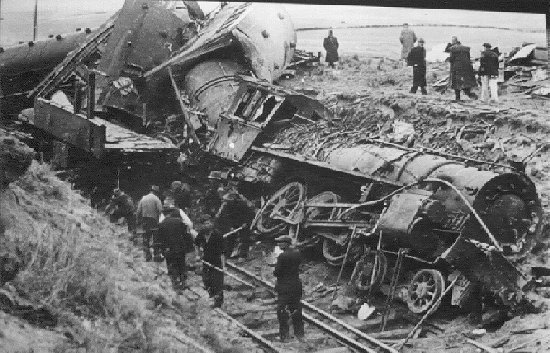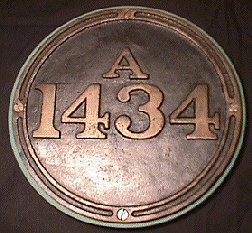New Zealand Railways
Hyde Disaster 4th. June 1943


The Board of enqiry stated about this accident.."It is safe to say that no previous railway accident in this country has resulted in such a mass of distorted and wrecked rolling stock."113 passengers were on board the Cromwell to Dunedin express when it left the rails at 1.45pm on 4th. June 1943, at great speed on a curve in a deep cutting just south of Hyde. Such was the speed that just before the derailment passengers and luggage were being thrown around inside the train. . 21 died and 47 were injured.
All Seven carriages were derailed and four of them telescoped together, the locomotive AB782 came to rest 60m. (200ft) past the point of derailment, the second carriage past the locomotive and overturned in front of it. The curve was 200m. (10chains radius).
One passenger was thrown through a window onto the embankment then back into the carriage through a different window, he escaped with cuts and bruises. An Alexandra passenger Mrs Mavis Sawera, had just given up her seat to a woman who was carrying a baby..both the mother and child died.
A farmer who heard the crash ran 1 mile for help nand on returning found his own son was one of those who died.
Because of difficulties in comunication it was about one and a half hours before rescuers began to arrive. In the meantime passenmgers from the rear carriages helped the injured.
~~~ Evidence ~~~
Evidence produced at the board of inquiry included the fact fact that an underframe of one of the carriages had been twisted into the form of a letter 'S', indicating an impact of such force that it could only have been made possible by speed of 112km (70miles) per hour. The speed limit on the curve was 48km (30miles)per hour.
Further evidence convinced the board that the engine driver had 'taken a quantity of alcohol sufficient to affect his judgement and sense of responsibility, he had taken more alcohol during the journey. He had carried more bottles of beer on the engine.
~~~ Findings ~~~
The inquiry found that the cause of the derailment was the overturning of the engine through the operation of centrifugal force, resulting from the engine entering a curve of 183m (9.88chains) radius at excessive speed. Further, the board found the engine driver guilty of serious derelection of duty and that the 'reckless manner' in which he drove his locomotive was the cause of the derailment. The guard was also repremanded for not taking counter action when the trains speed became excessive.
~~~ Results ~~~
The driver was charged in Dunedin Supreme Court with manslaughter, having killed certain persons 'by driving a railway train negligently and at an excessive speed'.He was found guilty and sentenced to three years reformative detention.
~~~ Actions ~~~
The board of inquiry's verdict made the Minister of Railways, the Hon. R. Semple, liable for compensation claims. About £400,000 was paid in claims.
Regulations relating to alcohol and drugs in service were tightened to try to ensure that nothing like this would happen again in the future.
~~~~~~~~~~~~~~~~
Two relics of the disaster
These plates were salvaged from one of the doomed carriages.


© 1998 email John Griffiths